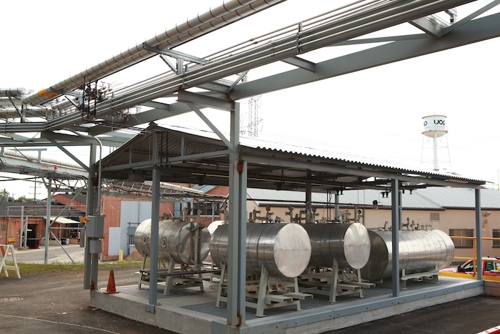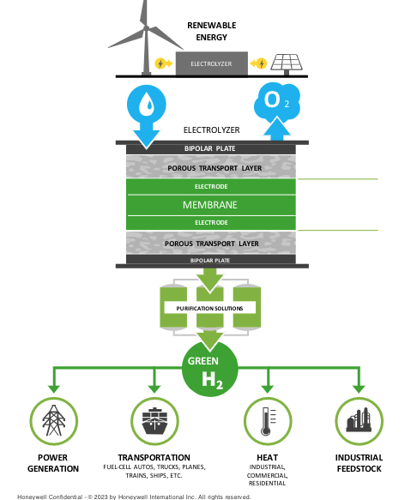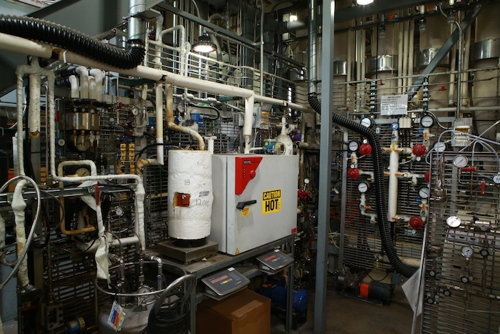Discovering Honeywell's pathways to sustainability: Highlights from Global Sustainability Week
Story by: Tyler Campbell, Managing Editor, H2Tech
To highlight their pathways to sustainability, Honeywell’s Global Sustainability Week took place from September 11–15 in Chicago, Illinois and Charlotte, North Carolina. The event took attendees to Chicago to tour their Riverside and Des Plaines labs, focusing on carbon capture, renewable fuels, hydrogen (H2) and plastics circularity.

The week began with opening remarks regarding analytical samples per year in their UOP labs, data points captured daily, catalysts prototypes and operating pilots. The Riverside UOP facility holds 9.0 acres of pilot plants, and the research moved to Des Plaines in 1955. The consolidated plants at Riverside in 1995 after the acquisition of UNOCAL technology buildings 1-3 were recognized as a National Chemical Historical landmark in 1996 (75th Anniversary), the birthplace of UOP’s catalytic process.
Kyle Austin described the role of Honeywell UOP’s pilot plants. The company’s pilot plants are pursuing the development of new technology (catalyst and materials performance testing), scaling new processes and products (process and plant design) and producing product samples for customers (testing customer feedstocks). UOP has 50 pilot facilities that operate nonstop, in which the company screens about 1,500 catalyst prototypes per year.
Decarbonization. Gavin Towler, Chief Sustainability Officer for Honeywell, delivered a presentation titled “Accelerating Sustainability,” highlighting the company’s contribution to decarbonization targets. Honeywell has had 6,300 global sustainability projects since 2004, of which more than 1,900 are lighting upgrade projects, followed by compressed air/gas upgrades and leak management (more than 600), heating, ventilation and air conditioning (HVAC) (more than 350), control system upgrades and replacements (more than 350), variable frequency drive (VFD) (more than 100) and industrial processes and production equipment (more than 100).
Sustainable aviation fuel (SAF). According to the International Energy Agency (IEA), in 2022, aviation accounted for 2% of global energy-related CO2 emissions. Honeywell has several products to drive sustainable aviation. SAF is a low-carbon alternative to traditional petroleum-based jet fuel, which reduces the carbon footprint of air travel by 60%–80%. Honeywell’s Ecofining technology can produce SAF using various feedstock, including algal oils, ethanol and animal fats. The company's eFining technology uses renewable energy sources to power the conversion of CO2 and H2 into liquid eFuels. Other sustainable aviation products the company offers are H2 fuel cells, electric power for hybrid-electric aircrafts, turbogenerators and electric propulsion units (EPUs).

According to Towler, Honeywell has technologies to combat 50% of global greenhouse gas (GHG) emissions in various sectors. The company has made notable contributions, such as the six green star rating from the Green Building Council of Australia (GBCA) for the Sydney Opera House, developed a 15-yr energy savings performance contract guaranteeing $17 MM in savings for Port St. Lucie in Florida (U.S.), enabling Port Esbjerg to reduce CO2 emissions by 70% by 2030 and reduce emissions in supermarkets with refrigerants.
Refrigerants. To discuss the benefits of Honeywell’s refrigerants, Dr. Amanda Josey, General Manager, Refrigerant Aftermarket, Honeywell Advanced Materials, delivered a presentation titled “The emissions-saving impact of a sustainable cold chain.” According to Dr. Josey, reliable refrigeration technology is critical for the cold chain, enabling the global production and transport of food supplies safely. Reducing food waste is a subject not often discussed regarding sustainability.
According to the United Nations, about 14% of food produced is lost between harvest and retail, and 17% of total food production is wasted. Refrigerants are used by farmers in temperature-controlled greenhouses to grow produce (using Honeywell’s Solstice® zd). The produce is transported in refrigerated containers or trucks [using Honeywell’s Solstice® liquid blowing agent (LBA)]; processing facilities then use refrigerants to keep the food cool (using Honeywell’s Solstice® N15) until they are transported to grocery stores that use refrigerant systems to store and display food (using Honeywell’s Solstice® N71 & Solstice® N40). Finally, they are kept fresh in the end user’s refrigerators/freezers (using Honeywell’s Solstice® LBA).
Refrigerants also play a role in the automotive market. Solstice yf (R-1234yf) is an energy-efficient refrigerant for mobile air conditioning with an ultra-low-global warming potential (GWP) of less than one, 99.9% lower than R-134a, a hydrofluorocarbon (HFC) refrigerant that has a GWP of 1,430. Sarah Martin, President of Honeywell Sensing and Safety Technologies and David Smith, Lead Research and Development (R&D) Engineering/Scientist, Honeywell Advanced Materials, delivered a presentation titled “Powering the future of electric vehicles (EVs).”
The presentation covered challenges regarding EVs and Honeywell’s solutions. Many EVs use lithium-ion batteries as an energy source, which can result in catastrophic failure due to batteries’ temperature increase, leading to fires. Honeywell’s Solstice yf traps less heat in the atmosphere than CO2, which has a GWP of 1. According to the presenters, heating/cooling a vehicle with CO2 uses 18% more energy than the exact vehicle with R-1234yf. If all EU vehicles (250 MM) utilized CO2 vs. R-1234yf, this would result in an increase of about 14 MM metric tpy of CO2 emission. Heat pumps using Solstice yf perform well in all climates, unlike heat pumps using CO2 refrigerant.
H2 and carbon capture. H2 utilization is another noteworthy pathway to decarbonization. Jeff Guenther, Project Development Director, Honeywell Carbon Capture Solutions and Maya Nair, Offering Director, Honeywell Green Hydrogen Solutions, delivered a presentation titled “Advances in hydrogen and carbon capture.” The presentation covered decarbonization overviews, carbon capture and H2 markets and projects in action.
Honeywell UOP has been developing H2 processing solutions for decades. The company does not make electrolyzers but does produce catalytic-coated membranes for the electrolyzer stack. Regarding blue H2, the process takes the CO2 traditionally emitted into the atmosphere, purifies it, and either stores it underground through industrial carbon capture and storage (CCS) or transports it for utilization in another industrial process. According to the presenters, of the 40 MMt of CO2 captured, 15 MMt (approximately 38%) were captured by UOP's technology. The company intends to be carbon-neutral in its operations by 2035.
H2 demand is expected to increase to 660 MMtpy by 2050. UOP has several purification and carbon capture processes revolving around steam methane reforming and autothermal reforming to meet these projections. H2 production with CCS (blue H2) will lead the market until around 2030, but by 2050, it is predicted to be evenly distributed between green and blue H2. Blue H2 technology is currently available, but green H2 has steps required to be cost-competitive. A blue H2 process takes the CO2 traditionally emitted into the atmosphere, purifies it, and either stores it underground through industrial CCS or transports it for utilization in another industrial process.
To contribute to green H2 production, Honeywell also has a catalyst-coated membrane (CCM). The technology focuses on CCMs for proton exchange membrane (PEM) and anion exchange membrane (AEM) electrolyzers. CCMs enable higher electrolyzer efficiency and higher electric current density enabled by a high ionic conductivity membrane and high activity catalyst, reducing electrolyzer stack cost.

Circular economy. Finally, plastics are a growing concern regarding sustainability efforts. Dean Rende, R&D Director of Plastics Sustainability, Honeywell UOP, delivered a presentation titled “Upcycle plastics recycling.” According to Rende, the annual global production of plastics (resins and fibers) has increased more than 200-fold since 1950—from 2 MMt in 1950 to 380 MMt in 2015, potentially reaching 1,100 MMt by 2050.
He continued to state that UOP technology-enabled monomers and plastics reduced GHG emissions by approximately 5.2 Gt CO2e. About 400 MMtpy of plastic waste is produced, of which 275 MMt (more than half) are single-use plastics. About 40% of global plastic waste winds up in the environment; 14% is recycled, but only 9% is used to produce new plastic.

Honeywell's UpCycle Process Technology utilizes molecular conversion, pyrolysis and contaminants management technology to convert waste plastic back to Honeywell Recycled Polymer Feedstock. Post-consumer resins (PCRs) are produced from the Recycled Polymer Feedstock, which is then used to create new plastics. The UpCycle Process technology expands the types of plastics that can be recycled to include waste plastic that would otherwise go unrecycled, including colored, flexible, multilayered packaging and polystyrene.
Honeywell’s Global Sustainability Week provided insight into the company’s various contributions to decarbonization. The technologies span from circular plastics and refrigerants to CCS and H2. Multiple pathways will be required to reach net-zero targets, and Honeywell is helping to pave the way.






Comments